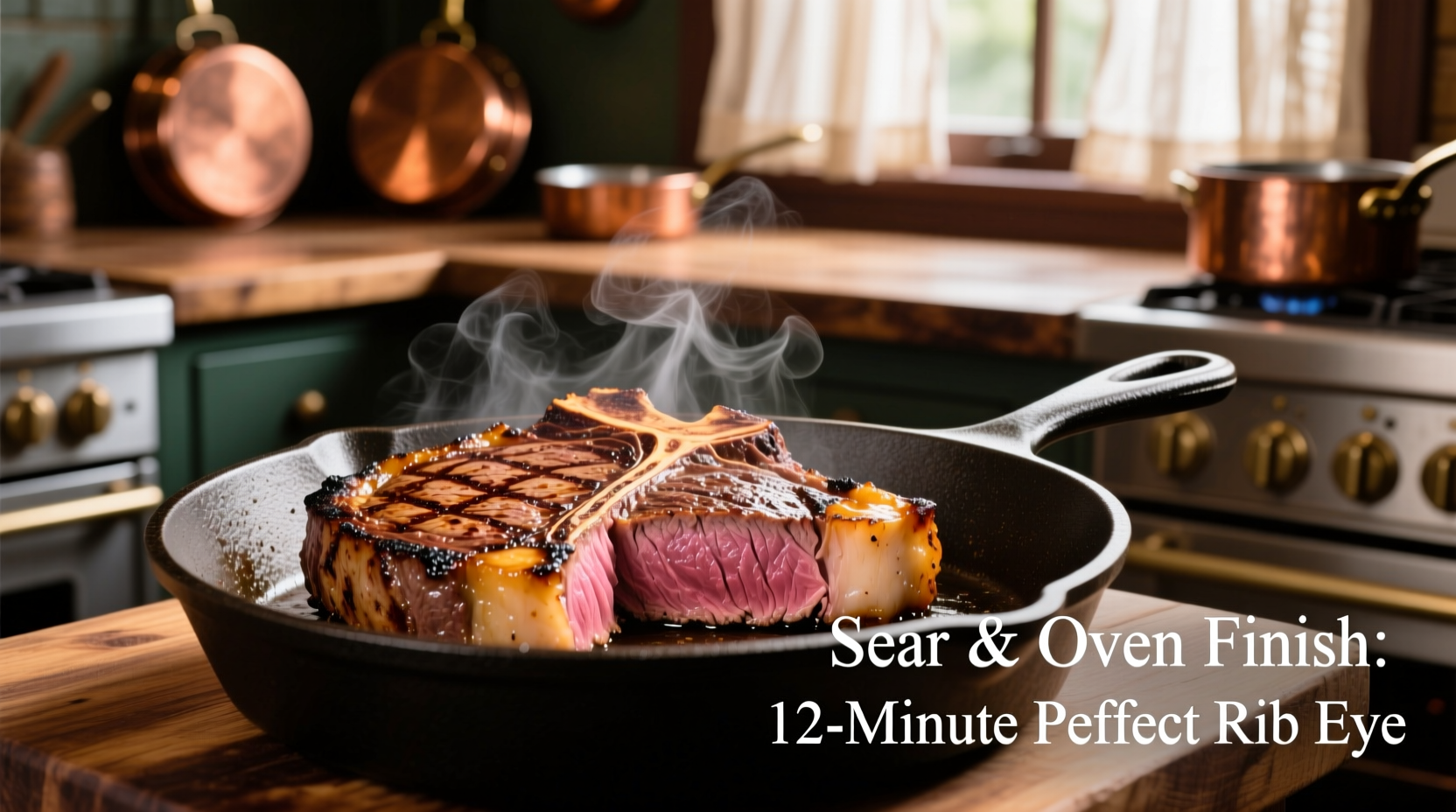Perfectly cook a restaurant-quality rib eye steak in your oven by bringing the steak to room temperature, seasoning generously, searing in a cast-iron skillet, then finishing in a 400°F (204°C) oven for 8-12 minutes depending on thickness and desired doneness. Always use a meat thermometer and rest for 10 minutes before slicing for maximum juiciness.
Why This Oven Method Works for Rib Eye Steak
Many home cooks struggle with uneven cooking or dry steak when using oven-only methods. The reverse sear technique—starting with oven cooking then finishing with a high-heat sear—creates the ideal balance of edge-to-edge doneness and that coveted caramelized crust. Rib eye's generous marbling melts during slow oven cooking, basting the meat from within for exceptional tenderness.
What You'll Need Before You Start
Gather these essentials to avoid mid-cooking frustration:
- 1-1.5 inch thick rib eye steak (bone-in for extra flavor)
- Cast-iron or oven-safe heavy skillet
- Instant-read meat thermometer (critical for precision)
- Kosher salt and freshly ground black pepper
- High smoke-point oil (avocado or grapeseed)
- Butter, garlic, and fresh rosemary (optional finishing)
Step-by-Step: Perfect Oven Rib Eye Steak
1. Selecting and Preparing Your Steak
Choose USDA Prime or Choice grade rib eye with even marbling throughout. Remove steak from refrigerator 60-90 minutes before cooking—this critical step ensures even cooking. Pat completely dry with paper towels; moisture is the enemy of proper searing. Season generously with kosher salt (1 tsp per pound) and freshly ground pepper on all sides.
2. Oven Setup and Initial Cooking
Preheat oven to 275°F (135°C). Place oven rack in the center position. Position steak on a wire rack over a baking sheet (don't skip the rack—air circulation prevents steaming). Insert meat thermometer probe into the thickest part. Cook until internal temperature reaches 10-15°F below your target doneness (see chart below).
| Doneness Level | Oven Target Temp | Final Temp After Rest | USDA Safety Guideline |
|---|---|---|---|
| Medium-Rare | 115°F (46°C) | 130-135°F (54-57°C) | 145°F minimum* |
| Medium | 125°F (52°C) | 140-145°F (60-63°C) | 145°F minimum* |
| Medium-Well | 135°F (57°C) | 150-155°F (66-68°C) | 160°F minimum |
*USDA recommends 145°F for beef steaks with 3-minute rest time for food safety. Source: USDA Food Safety and Inspection Service
3. The Critical Searing Step
Heat cast-iron skillet over high heat until smoking hot (about 5 minutes). Add 1 tbsp high smoke-point oil. Carefully place steak in skillet—don't move it for 90 seconds to develop crust. Flip and sear other side for 90 seconds. For extra flavor, add 2 tbsp butter, smashed garlic cloves, and rosemary sprigs during the last minute, basting the steak continuously.
4. Resting and Serving
Transfer steak to cutting board, tent loosely with foil, and rest for 10 minutes—this allows juices to redistribute. Cutting too soon releases precious juices onto the board. Slice against the grain at 45-degree angle for maximum tenderness. Serve immediately.

Common Mistakes to Avoid
Based on culinary institute research, these errors ruin otherwise good steaks:
- Skipping the dry step: Moisture creates steam instead of sear
- Overcrowding the pan: Lowers temperature, preventing proper browning
- Cutting too soon: Releases up to 40% of juices according to Cornell University food science studies
- Guessing doneness: Thermometers prevent $30 mistakes—always use one
When Oven Method Works Best (and When It Doesn't)
This technique shines with steaks 1.5 inches or thicker. For thinner cuts (under 1 inch), use stovetop-only method to avoid overcooking. The oven method also works poorly for frozen steaks—always thaw completely in refrigerator first. During summer months, this technique prevents overheating your kitchen compared to grill methods.
Troubleshooting Your Rib Eye Steak
Dry steak? Likely overcooked or insufficient resting time. Try removing 5°F earlier next time.
No crust? Pan wasn't hot enough or steak wasn't dry. Pat extra dry and ensure proper preheating.
Uneven cooking? Thickness varied—ask your butcher for even cuts or use the "butterflying" technique on thicker sections.
Pro Tips from Professional Kitchens
Michelin-starred chefs use these tricks at home:
- Season steak 24-48 hours in advance for deeper flavor penetration
- Add 1 tsp baking soda to salt for enhanced browning (food science hack)
- Use the broiler for last 2 minutes if oven sear isn't crispy enough
- Save rendered fat for roasted potatoes—the ultimate flavor booster











 浙公网安备
33010002000092号
浙公网安备
33010002000092号 浙B2-20120091-4
浙B2-20120091-4